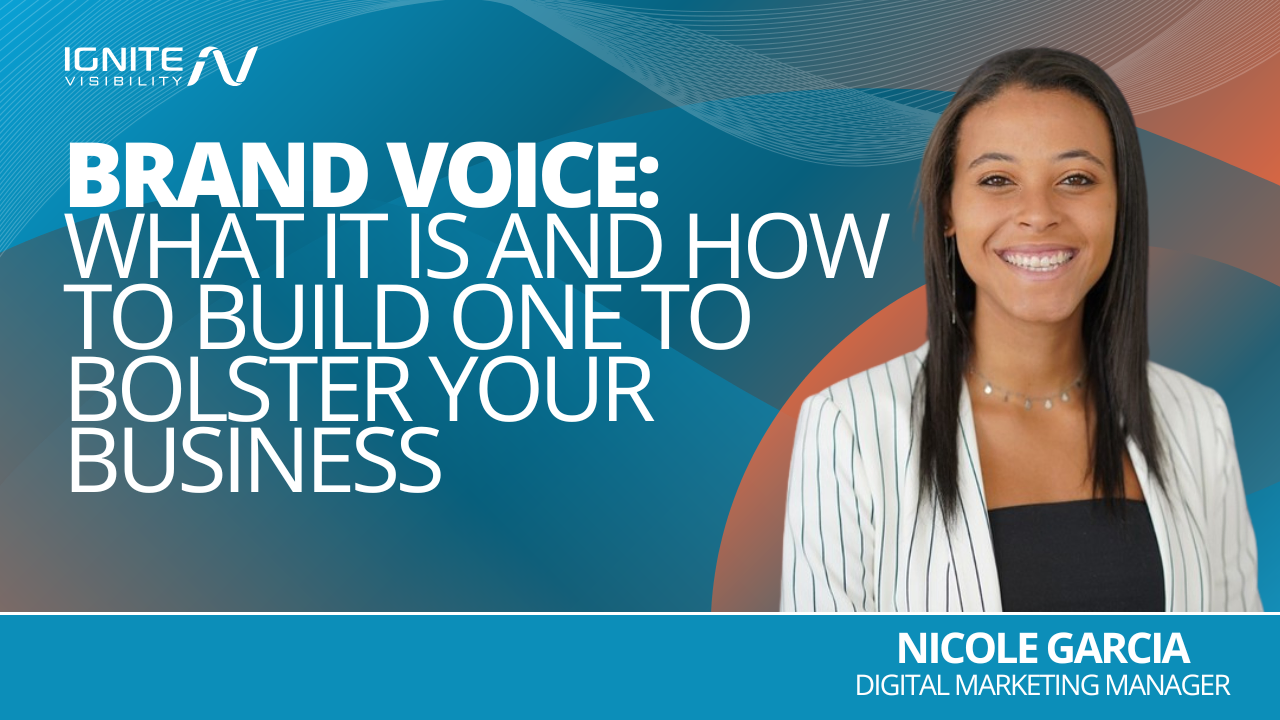
The larger your company gets, the more important your brand messaging and brand voice becomes. From your web page copy to what your employees are saying to your blog to social media, it should all align.
In this article, Digital Marketing Manager, Nicole Garcia, will walk you through some examples of strong brand voices, as well as go over some ways you can create one that matches your brand values and resonates with your target market.
What We’ll Cover:
- What it is
- What it is not
- Examples in marketing
- The steps to defining your own
- An outline for uncovering your brand voice
When you first start out, brand voice doesn’t come up all that often. You’ll talk about what you do and how you’re unique, but often without a definitive strategy for how you’ll express yourself in the context of an omnichannel strategy.
As your company grows and begins to develop a following across multiple channels, the more important it is to define your brand’s voice.
That means, from your web page copy to what your employees are saying to your blog to social media, it should all align.
When done right, it becomes a powerful tool for connecting with “your people,” bringing in more business and helping your company build a loyal following. On the flip side, when brands don’t quite get it right, their voice can cost them serious business.
In this article, I’ll walk you through some examples, as well as go over some ways you can find one that matches your brand values and resonates with your target market.
What is a Brand Voice?
So, what is brand voice?
Brand voice refers to your brand’s personality and use of emotions across all communications, along with how your communications express your values to each segment of your audience.
Voice comes through primarily through writing style, tone, and word choice, and successful brands keep these factors consistent across all channels.
Our core values are Relationships, Responsive and Results, or as per Co-Founder Krish Coughran, “The 3Rs”
We also have a clear mission statement and values. All of this plays into our brand and lets consumers know who we are.
You might try defining your brand strategy by using a chart like this one below, which can help you break down who you are and who you’re not.

It is just one part of your brand’s personality, but it’s an important one. Customers will also experience your brand through your logo and your digital presence online, but it’s your voice that comes through across all of these elements.
My Expert Opinion on Brand Voice
One of the most important aspects of any brand is how it sounds to its audiences. Does it speak to the audience’s values? Does it use their language? Does it stand apart from the way other brands sound?
Establishing a unique, memorable brand voice is essential in building recognition and trust, connecting with potential customers, and bringing them into the sales funnel.
Coupled with other aspects of branding, your brand voice and tone can mean the difference between a forgettable and unstable identity and a strong foundation for your marketing that drives conversions.
With a better understanding of what goes into brand voice development and how to tie this element into your marketing efforts, you can take full advantage of brand voices to steer your business to success.
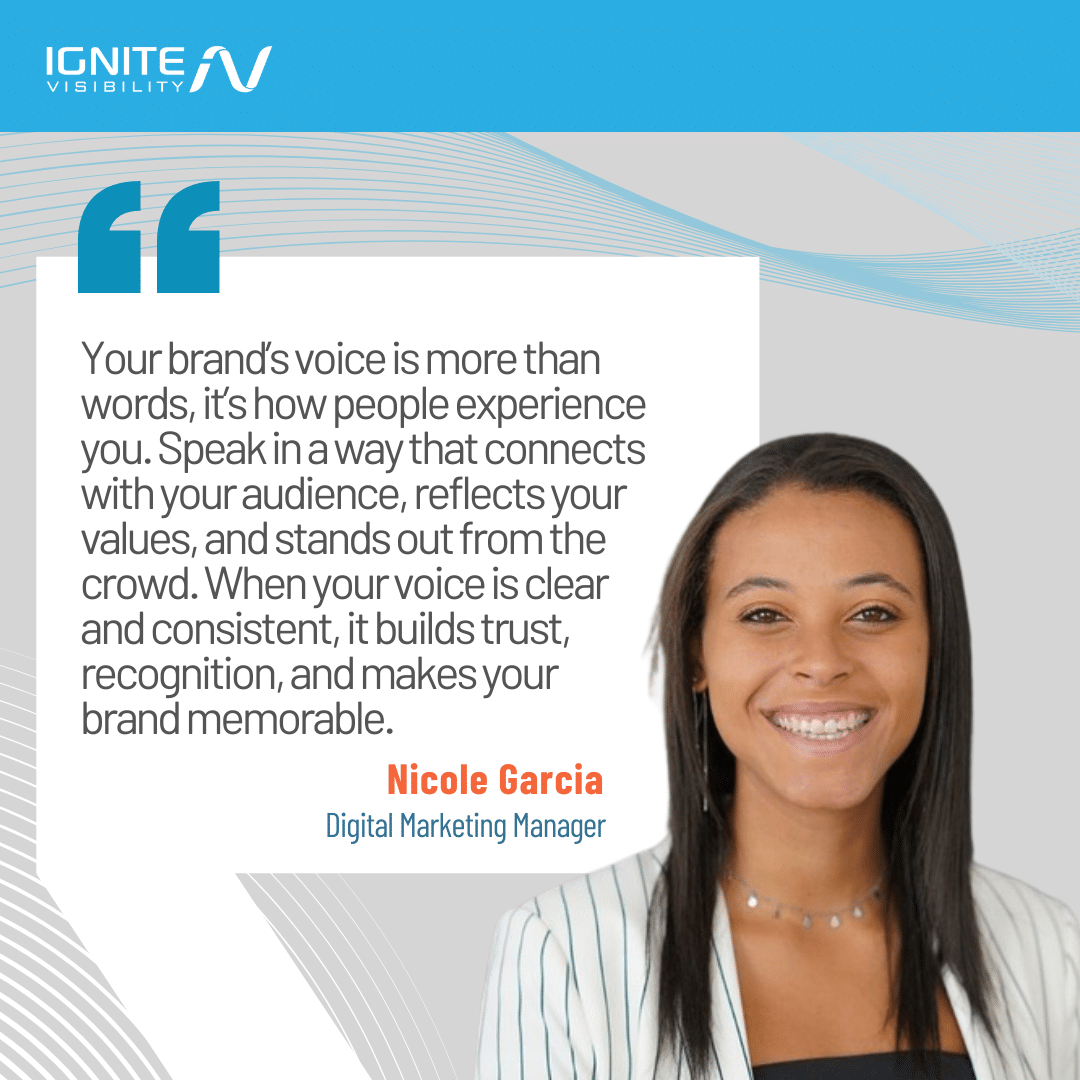
What a Brand Voice is NOT
It has nothing to do with grammar or spelling. It also should not be confused with “tone of voice.” It is consistent across channels and situations, whereas your tone shifts based on who you’re talking to, the channel, and the emotional landscape.
Things like whether or not you use slang, abbreviations, or off-book punctuation can impact how it is perceived, but ultimately, doesn’t define it.
For instance, a brand voice that’s targeting millennials may not be as concerned with traditional grammar rules as one that’s targeting an older demographic. It’s up to you to decide what yours isn’t, and that will largely depend upon the demographic you’re targeting.
Check out this ad for Forever 21.
Notice the language? It plays directly into the brand. “Best prices since like… Forever”
When a younger audience reads something like this, they identify with the style and voice and it attracts them, equaling sales.
It’s also important to distinguish brand voice vs. tone and style.
Here is a breakdown of the brand voice definition against tone and style to paint a clearer picture of each:
| Element | Concept | Constant/Variable | Owned by | Artifacts | Examples |
| Brand Voice | Brand voice refers to the overarching personality of a brand, including how it sounds and communicates its values and mission to target audiences | The brand voice should be constant, maintaining strong brand consistency across all platforms | The brand, which has full control over the establishment of its identity through a centralized voice | Mission and value statements, statements indicating what the brand is and what isn’t, and certain brand archetype documents | Humorous and confident; bold and motivational |
| Brand Tone | A particular inflection or emotion that modifies the brand voice to effectively communicate a particular message, but it can also be consistent in a brand’s default voice | Constant for basic branding but variable depending on a particular context, such as when speaking to a specific audience or communicating a unique message | Content creators and communicators based on the brand voice definition of the company | Frameworks that indicate how to adapt the brand voice to match a designated tone, whether it’s empathetic, light-hearted, or another emotion | A brand might use a more empathetic brand tone to connect with customers based on complaints while getting more playful and emphatic when launching a new offering |
| Brand Style | Applies to more technical elements that dictate the grammar, punctuation, and visuals associated with all content | Should be constant to streamline the style across all content pieces, helping establish a distinct brand voice | The brand is in control of the style, often with a style guide that aligns all brand messaging and tone with the designated mechanical requirements | Principally the brand style guide that includes instructions for grammar, capitalization, punctuation, terminolog,y and other more technical components like fonts and color schemes | A brand might have specific rules for abbreviations, capitalization of proper nouns, the use of an Oxford comma, and more |
Why Brand Voice Matters
Okay, so you know the answer to “What is a brand voice,” but why do you really need one today?
Well, the data suggests that a strong brand voice and tone is now more crucial than ever, especially with so many brands vying for people’s attention, patronage, and long-term loyalty.
Here are some stats that prove just how important it is to have a specific brand voice definition backing your company:
- 76% of people prefer to purchase products from brands with which they connect over impersonal competitors
- 70% of audiences also like brands whose CEOs are active and communicative on social media
- Around 85% of businesses have brand voice guidelines in place, but a mere 30% enforce them
- 90% of consumers want to see a consistent brand experience across platforms
- Shared values are the main reason 64% of people remain loyal to a brand
These and other stats reveal just how important brand voices are for companies today as they establish their values, offerings, and other aspects to help set them apart.
Why Multi-Location Businesses Struggle With Brand Voice
What is brand voice without consistency at every touchpoint? Ultimately, it’s not very effective.
As companies with multiple locations attempt to grow through effective franchise marketing and multi-location campaigns, they can easily struggle to maintain that cohesive branding while adapting it to the unique needs of each location.
The main reason for this struggle is the branching out to multiple locations and the lack of readily available brand voice guidelines and templates in place for every location.
As new management takes over each location, it’s important to provide each location with specific brand voice templates and ensure that the centralized theme and voice remains intact. At the same time, each location should be able to adapt that voice and tone to each community to establish a stronger connection.
For example, one location might want to adapt a brand voice template to speak to a particular culture within a specific region, connecting the brand to that community’s unique values with empathy while still using recognizable language that’s unique to the brand.
Providing a range of resources for each location to use in its marketing and general communications can align all locations with the overarching brand voice while allowing for some flexibility when communicating with each location’s audience.
If you want some help with your efforts as your company expands, you could benefit from working with one of the most affordable brand voice development companies in the U.S. like Ignite Visibility. Here, we give you access to a reliable AI brand voice generator via Rallio, which makes social media management easy. Using this tool, you can ensure your voice aligns with your audience’s needs on every social platform, monitor engagement, and continually optimize your social media strategies with effective content creation and much more.
Examples of Strong & Unique Brand Voices
Here are a few different examples that you may have seen. Keep in mind the style that each of these brands uses and the emotions they evoke with their communications.
DiGiorno Pizza
DiGiorno pizza: humorous, subversive, and at times is extremely clever.
During a live telecast of “The Sound of Music” back in 2013, DiGiorno filled their Twitter feed with tweets like this:
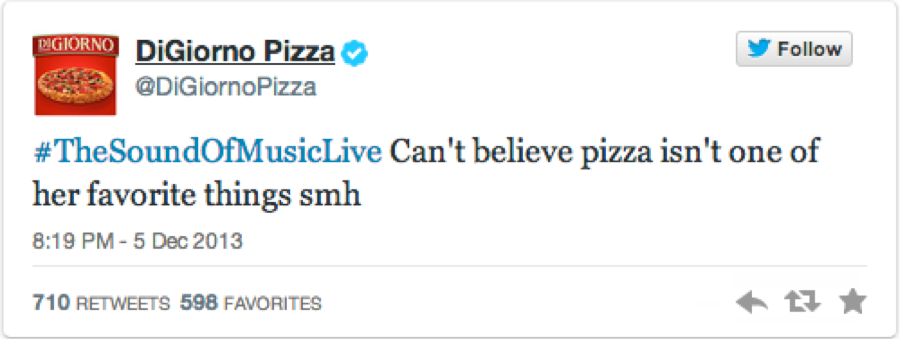
Notice how they’re clearly targeting millennials with these tweets because they’re adopting the nomenclature of that age group with “smh” (shaking my head).
Their tweets are funny and timely, and they obviously know their target audience quite well. Think, who buys take-home pizza? I tell you who, I did! But that is when I was back in college at UC Santa Cruz. Not today. Although it does sound good right now.
Try This: Adapt your social media language to more directly speak to your audiences with timely references and, when appropriate, some humor.
Nike
Everyone knows Nike for its brand slogan “Just Do It,” which has become a staple of American culture.

Nike’s is inspirational, it’s almost pushy, and it forces you to want to improve yourself (motivation, I love it! Makes me want some new Nike shoes to run in). This particular Instagram ad shows a photo that inspires people to want to keep their workouts going. Not coincidentally, Nike advertises its products subtly in the caption.
But the emotions this ad generates in the followers is the real story here. It’s almost impossible to look at this, or any Nike ad for that matter, and not feel compelled to both get off the couch and swap your old sweatpants for some sleek, performance sportswear.
Try This: Imbue your content with a sense of inspiration to really motivate your audiences to engage with your brand and offerings, which could involve showing what your customers can achieve with your products or services.
Warby Parker
Warby Parker is notable for their sophisticated, almost high-brow brand voice. But they’re also notable for their ability to make their target audience feel like they’re a part of the conversation.

Warby Parker makes you feel like you’re being spoken to directly. They make you feel like, no matter what, your opinion matters to them.
Much of Warby Parker’s social media (especially on X), makes use of polls, open-ended questions, and user submissions in order to get their marketing messages across. The result is a customer-focused brand that uses an inclusionary brand voice to get their point across, without sacrificing any marketing messages. You always know when you’re reading a Warby Parker ad, but it doesn’t feel like an ad.
Need help amplifying your brand on social media? Learn more about our Social Media Marketing Services.
Try This: Connect with your audiences more directly by using your voice to drive more engagement, whether it’s by asking questions and requesting opinions or encouraging audiences to submit their own content to supplement your brand voice.
Sephora
Sephora caters mostly to millennial women. Their brand strikes an educational, informative tone. Users are given tips, tricks, and educational content that helps reinforce their brand while subtly advertising their products:
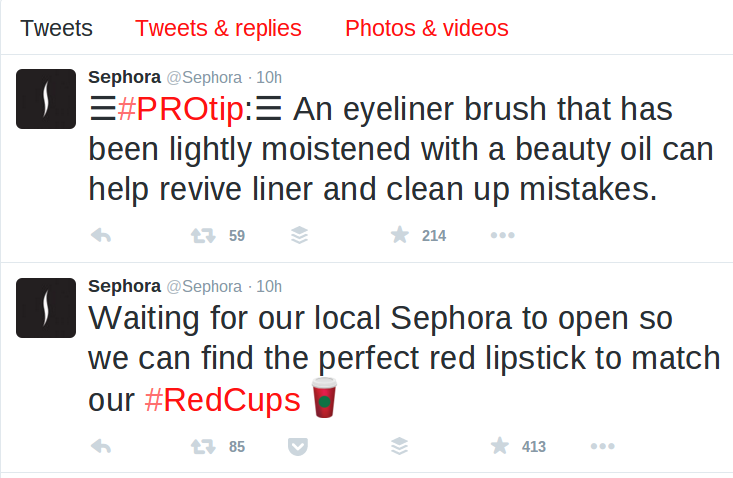
Sephora’s content provides followers with the information they can actually use and has cultivated an online community where members review products and share their own tips, tricks, and photos.
Try This: Utilize your brand voice and tone to bring real value to your audiences through helpful content, from tutorials to pro tips that give your customers the resources they need while building thought leadership in your industry.
Slack
This project management tool is increasingly popular among many businesses, and the company loves to highlight its users’ experiences while displaying a sense of empathy.

This and other posts on Slack’s social media demonstrate how to build a B2B brand voice that resonates with business owners and entrepreneurs, especially by showing how they benefit from using a particular solution.
Try This: In developing a brand voice for a B2B business, establish brand voice guidelines that emphasize your customers’ success with your offering, potentially highlighting and using a celebratory voice to promote success via testimonials and other content, which can go a long way in converting more business customers.
Notion
Notion is a web-based workspace centralizing project management, note-taking, and more with the help of AI. The company is always showcasing its many capabilities to connect with its target audiences on social media.

Using platforms like X, Notion focuses on providing people with helpful tips to get the most from its platform and advertise its many features, appealing to existing and prospective users alike.
Try This: When offering a solution that includes a wide range of features, or if you simply want to explore your offering’s various capabilities more in depth, prioritize helpfulness in your brand voice development as you promote your solution and brand.
Duolingo
Another brand that has mastered its brand voice development is language-learning app Duolingo, which is always looking for ways to get creative with its branding and demonstrating how to grow on social media.
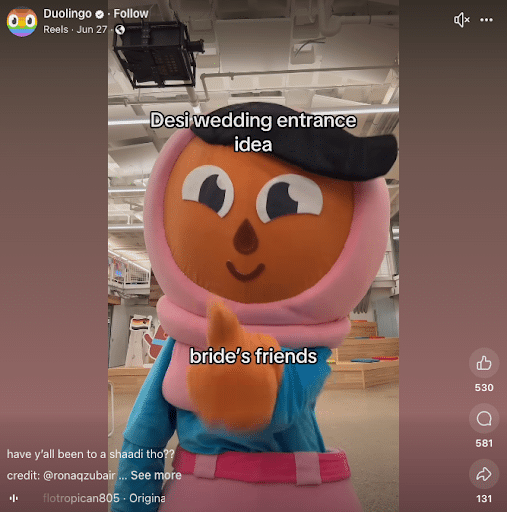
Duolingo is all about inclusivity and encouraging people to connect with each other all over the globe, with an empathetic look into various cultures and languages to entice its users to learn a new language. At the same time, the company adapts its voice to different memes and trends to stay relevant, making it a consistently “hip” company that is especially connected to younger audiences eager to learn.
Wendy’s
If you wanna stay really trendy and on top of your social media game, you can take a cue from fast-food chain Wendy’s and their witty posts. Wendy’s gets really crazy with its social media, allowing its reps to have some real fun with their posts as they make people laugh while driving engagement.

Wendy’s particularly likes to poke fun at the older generation of social media users while making some truly off-the-wall posts. That kind of humorous unpredictability really makes the brand stand apart from its more serious competitors.
Try This: Find a way to differentiate your voice from others, whether it’s through humor, touching on particular pain points, or other elements that your competitors are overlooking. You might find that you’re able to stick out and become far more memorable in the process.
How to Define Your Own
Here are all the steps to follow when you define your own brand voice:
1. Define Your Mission and Values
To start with, define your brand mission and core values, which will give brand voices a clear direction.
For example, a company establishing a B2B brand voice might have a brand mission to “empower small businesses with innovative marketing tools to grow and succeed.”
To accompany your brand mission, you should also have a specific set of values in place. Examples of some core values might include:
- Transparency
- Sustainability
- Creativity
- Affordability
- Efficiency
These components could then contribute to a brand persona that best represents your business and what it’s about.
2. Research Your Audience and Competition
Once you have a good handle on what your brand wants to achieve, you can start looking into your audience.
Conduct in-depth audience research to learn about what kinds of brands they follow and the voices they respond to best.
Think about the kinds of attributes that appeal most to them and how you can maximize your brand’s connectivity.
Engage in social media listening, conduct interviews and surveys, and watch for how other brands in your industry connect with your target audience.
As you segment your target audience into different groups who will respond to unique voices and tones, you can develop audience personas for each.
3. Develop Your Messaging Pillars
Consider the specific themes and ideas that bolster your brand voice. These items will form the foundation of your messaging pillars.
For instance, think about the key benefits your brand and offerings provide, developing them into the core benefits you want to advertise.
At the same time, ensure those benefits align with audience needs, whether you’re addressing a particular pain point, value, or goal.
Try to shoot for creating around three to five pillars covering the most important advantages that will appeal to your audiences.
Some examples here might include:
- Pillar 1: Authenticity: We only develop and maintain relationships with the companies we believe in.
- Pillar 2: Expertise: We work to maintain our status as industry thought leaders and innovators.
- Pillar 3: Opportunity: We always seek to help our clients flourish by giving them access to the most vital resources they need.
4. Use Sliders to Define Your Brand Voice and Traits
In your guidelines, use sliders to further define your voice and characteristics for a better understanding among your teams.
For example, you might have a set of five sliders, each covering different tones like:
- Humorous
- Playful
- Empathetic
- Sincere
- Transparent
You might then expand on each of these tones and how to align them with your unique voice and style.
5. Prove How Your Voice Works With Concrete Examples
Give some examples of how your voice should sound in different contexts, which will give marketers even more guidance on how to approach different methods of communication.
An example here could include illustrating the differences between right and wrong when trying to express the trait of “Confidence.” Here, you might indicate:
- Right: “Here’s how we can get you started.”
- Wrong: “You might want to consider trying…”
In this step, give examples of the kind of rhythm, length, and structure of your messaging that work best.
6. Establish Specific Guidelines and Guardrails
To further ensure your branding remains consistent and authentic, you should:
- Develop a style guide that keeps track of all brand elements, from the specific terms you want to use and grammar to adaptation techniques for various channels.
- Appoint a specific individual or team to help manage the voice and maintain consistency, enforcing your guidelines.
- Train content writers and others on the guidelines and guardrails in place.
- Regularly monitor your efforts with content audits.
Bonus! 7. Connect Your Brand Voice to Emotions
One of the most powerful ways to use it is to tap into specific emotions that trigger a response with your customer.
In doing so, your brand can generate a feeling which is associated with the value your product or service provides. It’s up to you to figure out what that emotion is depending on your industry and niche, but you can see the power of this effect in an example like Nike.
Nike’s marketing forces you to feel something and the way you feel about those ads compels you to satisfy that urge specifically by purchasing Nike products.
Define Your Brand Voice Now
Sit down and write it down on a piece of paper using this outline:
-
- Create three personas
- What is your core company message?
- What is your company’s mission?
- What are your core products to promote?
- What tone of voice do you use in your communication?
- How do you want to interact with customers?
- How do you not want to interact with customers?
- What things should your company never say (specific words, phrases, promises)?
- List some examples of content that is approved and on-brand
Of course, you should also use the right artifacts to establish your voice, tone, and style, including:
- Personality Spectrum: The personality spectrum of your brand voice refers to the company’s core traits and characteristics as a cohesive identity, much like a person. Think of some specific adjectives that best describe your essence, clearly establishing your purpose and values, e.g., “We are friendly and enthusiastic, but we are not overly informal or cringey.”
- Do/Don’t List: Create a list of dos and dont’s when it comes to how to properly use different voices or tones, or guidance on correct vs. incorrect style. (E.g., Do: Use active voice to give your writing some authority. Don’t: Use passive voice that weakens your writing.)
- Banned Phrases: Incorporate a list of phrases that aren’t part of your designated vocabulary, potentially going against your desired tone or style.
- Inclusive Language Rules: Some terms and language might also be more inclusive than others, encompassing all of your target audience without leaving anybody left out, in which case you should indicate which language maximizes inclusivity.
- Sample Copy Blocks: To demonstrate how your voice will apply to different types of content, offer up some copy blocks that show content in the form of everything from social media posts on different platforms to email newsletters and product descriptions.
- Template Snippets: Brand voice templates could also come into play in helping simplify adaptation, keeping your voice and messaging consistent on all platforms while allowing for basic adaptability, such as calls to action that direct people to “Learn more about [Product Name] with this complete guide!”
Tools and Workflows for Brand Voice Development
Want to make it easier than ever to develop your brand voice and tone? Here are some great tools you can use:
- Semrush Brand Voice: This AI brand voice generator can help you create content that sounds like your brand based on an uploaded writing sample. Upon uploading said sample, the tool will analyze it to detect a particular tone, the language used, and communication method, using it to inform its own output.
- Grammarly Business: This is another solution that can assist with content creation and optimization to align it with your voice. It can ultimately increase the efficiency of your writing, incorporate guidelines around inclusivity and overall responsible communication, and boost content quality.
In addition to implementing these tools, be sure to implement the right workflows to optimize quality and compliance with your guidelines.
Here is a complete checklist for quality assurance when developing and enforcing your brand voice rules:
- In-depth research and discovery to define your voice, complete with brand and audience personas
- Detailed documentation and brand voice definition, including style guides, reference examples, dos and don’ts, and banned language
- Continual A/B testing and refinement, with internal feedback from creative and other departments
The following workflow can also help you keep these processes consistently efficient:
- Draft creation under a Brand Manager or Content Strategist
- Internal review and feedback from department heads, marketers, and content creators
- Brand compliance checks overseen by marketing heads or a Brand Custodian
- Legal review from a Legal and Compliance Team to mitigate the risk of noncompliance with industry regulations
- Sign-off and final approval from CEOs, CMOs, or other executives
- Implementation and launch under the guidance of content teams, internal communicators, or a Brand Manager
- Continual review and auditing to maintain consistency and compliance
Build a Strong Brand Voice With Ignite Visibility
If companies want to establish their brand voices effectively as part of a strong identity, it helps to work with experts who can help with every aspect of this process. Ignite Visibility is one of the most affordable brand voice development companies in the U.S., with strategies that yield high ROI through comprehensive branding services.
With our experts behind you, you’ll be able to:
- Define your unique voice, along with your style and tone
- Integrate this style into all marketing elements, including social media, email campaigns, paid media advertising, search engine optimization, website design, and more
- Implement innovative tools to conduct regular audits and maximize compliance
- Continually monitor efforts based on your goals to inform future optimization
Want to find out what we can do for your brand? Get started today with a free proposal!



